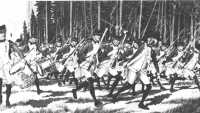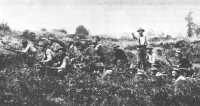Part One: Introduction to the Marine Corps
Blank page
Chapter 1: Origins of a Mission
In a sense, Marines may be said to have existed in ancient times when the Phoenicians, and subsequently the Greeks and Romans, placed men aboard their ships for the specific purpose of fighting, in contrast to the crews who navigated them and the rowers who propelled them. However, Marines in the modern sense date to Seventeenth Century England where, in 1664, a regiment of ground troops was raised specifically for duty with the fleet as well as ashore. This unit bore the somewhat ponderous title: “Duke of York and Albany’s Maritime Regiment of Foot.” Over a period of many decades of expansion and evolution, during much of which nobody knew for certain whether it belonged to the Army or the Navy, this basic unit developed into the corps known today as the Royal Marines.
By the time of the American Revolution, the status of the British Marines had jelled firmly. Thus, when the American Colonies revolted and began setting up their own armed services, they modeled these much along the lines of the similar components of the mother country, these being the forms with which they were most familiar and which suited them best temperamentally. This was true of the Continental Marines and to an even greater degree of the Marine Corps, reactivated under the Constitution in 1798.
In the days of wooden, sail-propelled ships the functions of the Marines became well defined. At sea they kept order and were responsible for internal security. In combat they became the ship’s small-arms fighters: sniping from the fighting tops, and on deck spearheading boarding parties in close action or repelling enemy boarders. Ashore they guarded naval installations, both at home and abroad, and upon occasion fought on land beside Army components. Amphibious-wise, they were available as trained landing parties, either to seize positions on hostile shores, or to protect the lives and property of nationals in foreign countries. Both the British and U.S. Marines have seen much such service.
At the time of this writing the Marine Corps is 181 years old, according to its own reckoning, though its service has not been continuous. Marines celebrate their Corps’ birthday on 10 November, this being the date in the year 1775 when the Continental Congress authorized the raising of two battalions of Marines for the Continental service. The scanty records extant show nothing to indicate that those battalions were actually raised, but many Marines were recruited for service on board the ships of the infant Navy where they performed creditably in all the major sea actions of the Revolutionary War, staged two important amphibious landings in the Bahamas, and ashore participated in the Trenton-Princeton campaign under General Washington.
The Continental Marines, like the Navy and all but a minuscule detachment of the Army, passed out of existence following the close of the Revolutionary War. However,
foreign pressures brought the Navy back into existence in 1798 under the recently adopted Constitution, and on 11 July of that year the Marine Corps was reactivated as a separate service within the naval establishment.
Since that date Marines have fought in every official war the United States has had—and scores of obscure affairs that lacked official blessing but in which, to quote the eminent Marine writer, John W. Thomason, Jr., “... a man can be killed as dead as ever a chap was in the Argonne.”1 They have served as strictly naval troops, both ashore and afloat, and participated in extended land operations under Army command, notably in the Creek-Seminole Indian Wars of the 1830s, the Mexican War, both World Wars, and in Korea.
All over the world, Britain’s Royal Marines were seeing much the same type of service. For a century or more the courses of the two corps ran parallel, and they were as functionally alike as it is possible for any two military organizations to be. Individual members of these services had so many interests in common that, as one British writer put it, they had a tendency to “chum up”2 when ships of the two nations put in to the same ports. Even the present U.S. Marine emblem (adopted in 1868) derives from that of the Royal Marines; though at a glance they appear entirely different, the basic motifs of both are the fouled anchor and globe: the Eastern Hemisphere for the British, the Western for the U.S. Much in common existed at top level, as well, and over the years the two organizations developed a very close and most cordial relationship that exists to this day, despite the strange evolutionary divergence that set in between them.3
The transition of navies from sail to steam began evolutionary developments which profoundly altered the nature of all shipboard duties, and temporarily threatened both corps with extinction. From this the Royal Marines emerged burdened with a miscellany of often incongruous duties never envisioned in the old days, and considerably emasculated by lack of a single mission of overriding importance. That the effect on the U.S. Marines was precisely the reverse resulted from the fundamental difference in the problems facing the two nations which required U.S. Marines to carve out a special mission for themselves, though they traveled a long, uneven road in bringing this to full fruition.
The basic problem that confronted the early steam navies was that of obtaining fuel. Sail-propelled men-of-war, on which all naval experience and tradition up to the time was based, could operate at sea almost indefinitely, putting in only to replenish provisions and water, readily available at nearly any port of call anywhere in the world. But sufficient coal to support large-scale steamship operations could be obtained only from well stocked bases, and a fleet’s operating radius thus became limited by the location of such bases. If an enemy lay beyond that radius, the fleet might as well be chained to a post so far as getting at
him was concerned, unless the source of supply could be projected farther in his direction.
To the British Empire, on which “the sun never sets,” this posed no serious problem; it had, or could build, all the bases it needed without leaving its own territory. But the United States, with few outlying possessions, had genuine cause for concern. In order to give the fleet significant operating range in the Pacific, the Navy in 1878 set up a coaling station in Samoa, and in 1887 the government concluded a treaty with Hawaii permitting the establishment of another at Pearl Harbor.
But the United States had no deep-seated interest in the Far East during this era, and no serious apprehension of an attack from that direction. The Navy’s principal concern lay in the possibility of being obliged to enforce the Monroe Doctrine in the Caribbean or South Atlantic. As early as 1880, far-sighted naval officers began turning their thoughts toward this mission. The cost of maintaining permanent bases in those areas would have been prohibitive, so the problem boiled down to devising a plan for seizing advanced bases when and where strategy dictated their need and developing these as quickly as possible to withstand attack. The scattered, understrength U.S. Army of that era could not supply sufficient trained ground troops on the short notice necessary to make such operations effective, so the Navy faced the problem of developing ground troops of its own for service with the fleet.4
It would seem, particularly with benefit of today’s hindsight, that the Marine Corps would be the logical choice for the development of this mission. However, this was not so apparent at the time. Marines had never participated in this type of operation on anything resembling the scale envisioned, and they comprised a very small unit as compared to the bluejackets. One school of thought contended that the advanced base function should be performed entirely by Navy personnel under command of naval officers, in the interests of unity and other considerations.5 The controversy, strictly on the theoretical level, waxed warm and sometimes acrimonious, giving rise at length to one of those perennial efforts to eliminate the Marines altogether.6
However, the advent of the Spanish-American War found the Navy wholly unprepared to cope with the advanced base problem. It was the Marine Corps that promptly organized an expeditionary battalion, including its own artillery component, for the seizure of Guantanamo Bay, Cuba, in order to enable the U.S. Fleet to operate indefinitely in the Caribbean waters. At Key West this unit underwent training in minor tactics, basic weapons, and musketry, and then landed in the target area on 10 June 1898, ten days before the first Army troops arrived off the coast of Cuba. There the Marines quickly secured a beachhead and successfully defended it against a numerically superior enemy.
Continental Marines present a stirring sight as they charge in this symbolic painting of Revolutionary fighting by H. Charles McBarron, Jr. (USMC 304045)
Marines of Huntington’s Battalion, first troops ashore in Cuba in 1898, captured Guantanamo Bay, used thereafter as an American naval base. (USMC 4982)
So expeditiously and efficiently was this operation conducted that its contribution to the speedy and decisive culmination of the war would be difficult to evaluate. This also greatly strengthened the Marine Corps’ claim to the Navy’s amphibious mission, a claim that gained still further strength by Admiral Dewey’s subsequent statement that if a similar Marine component had served with his fleet at Manila Bay, the painful and protracted Philippine Insurrection might have been avoided.
The Spanish-American War signalized emergence of the United States as a world power. Possession of the Philippines caused the Navy to reappraise the whole Far East situation. The USS Charleston, convoying Army troops to Manila, paused en route to seize the Spanish island of Guam to serve as an advanced coaling station,7 and annexation of Hawaii followed shortly.8 Additional advanced bases were established in the Philippines themselves as soon as the situation permitted.
This increasing consciousness of the Navy’s widespread commitments and responsibilities brought about the evolutionary developments which culminated in the early 1940s in the amphibious assault doctrines and techniques “which finally made possible what Major General J. F. C. Fuller has called ‘the most far-reaching tactical innovation of [World War II].’”9

